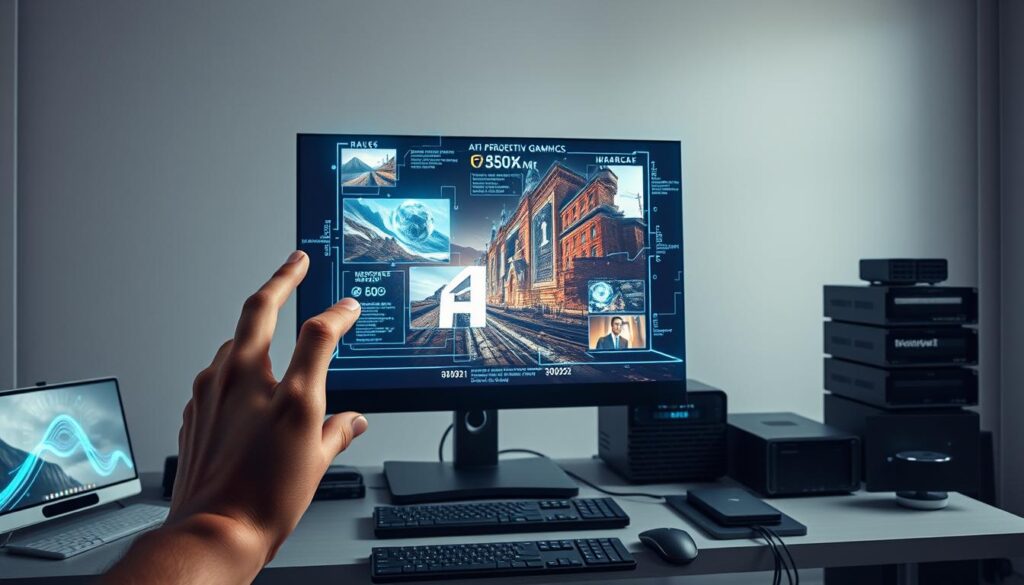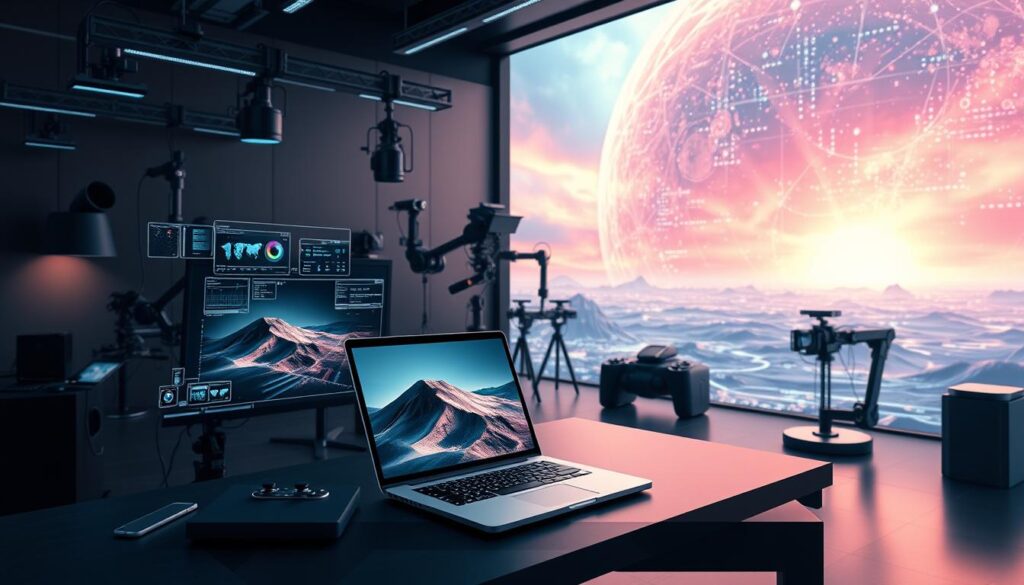Imagine describing a scene, and within moments, seeing it come to life as a vibrant, high-resolution image. Sounds like magic, right? This is the power of advanced image generation tools like DALL-E 3, developed by OpenAI. This cutting-edge model transforms text prompts into detailed visuals, making it a game-changer for creators and beginners alike1.
Whether you’re crafting a unique art style or visualizing a complex subject, this tool offers endless possibilities. It’s integrated with platforms like ChatGPT Plus and Bing Copilot, making it accessible for users of all skill levels2.
But here’s the catch: while it’s a powerful tool, it doesn’t replace the creativity of human artists. Instead, it enhances your creative journey, offering a new way to bring ideas to life. Ready to explore how it works? Let’s dive in!
Key Takeaways
- DALL-E 3 transforms text prompts into detailed images effortlessly.
- It’s integrated with platforms like ChatGPT Plus and Bing Copilot.
- This tool enhances creativity but doesn’t replace human artistry.
- It’s beginner-friendly, making it accessible for all skill levels.
- High-resolution results make it ideal for personal and professional projects.
Introduction to DALL-E 3: A Beginner’s Guide to AI Image Generation

Transform your ideas into stunning visuals with just a few words. DALL-E 3 is a groundbreaking tool that converts text descriptions into high-quality images. This innovative approach makes it easier than ever to create digital art, even if you’re just starting out3.
The key to unlocking its potential lies in crafting detailed prompts. The more specific your description, the better the result. For example, adding details about the art style, background, or main subject can significantly enhance the final image4.
This model is designed to be beginner-friendly, making it accessible to users of all skill levels. It’s integrated with popular platforms like ChatGPT Plus and Bing Copilot, allowing you to generate images seamlessly3. Whether you’re a creator or just exploring, it’s a great way to enhance your creative journey.
However, it’s important to understand both its capabilities and limitations. While it excels at producing detailed visuals, it may occasionally struggle with text accuracy. This makes it a powerful tool for inspiration rather than a replacement for human creativity4.
For those looking to dive deeper, platforms like AI Tools offer additional resources and tips. With DALL-E 3, the possibilities are endless, and your imagination is the only limit.
How to Access and Set Up DALL-E 3

Getting started with this innovative tool is easier than you might think. Whether you’re a beginner or an experienced user, there are multiple ways to access this powerful model. Let’s explore the options available to you.
Using ChatGPT, Bing Copilot, and U-M GPT
One of the most popular ways to access this platform is through ChatGPT Plus. For $20 per month, you can unlock its full potential, including the ability to handle long, complex queries effectively5. If you’re looking for a free option, Microsoft Bing Copilot offers daily credits, making it a great choice for casual users6.
For university users, U-M GPT provides seamless integration. Simply navigate the dropdown menu to start generating images. Each platform has its unique features, so choose the one that best fits your needs.
Exploring Platform-Specific Features
Each tool offers distinct advantages. ChatGPT Plus excels in conversational flow, allowing for easy follow-up requests5. Bing Copilot, on the other hand, is perfect for those who want to experiment without a subscription. U-M GPT is tailored for academic use, making it ideal for students and researchers.
To optimize your experience, read the platform guidelines carefully. For more tips on using Bing Copilot, check out this guide.
By understanding the strengths of each platform, you can make the most of this cutting-edge tool and bring your ideas to life.
Mastering Prompt Crafting for Stunning Image Generation
Your words hold the power to shape breathtaking digital art. Crafting detailed and descriptive prompts is essential for generating impressive visuals. The more specific your description, the better the result. For example, a prompt like “a robot walking a dog in the style of Vincent Van Gogh” yields a unique and visually striking image7.
Descriptive Prompt Writing Techniques
Start by including details about the subject, background, and art style. This helps the tool understand your vision. For instance, instead of “a cat,” try “a fluffy white cat sitting on a windowsill with sunlight streaming in.” The added context enhances the final result.
Experiment with adjectives and phrases to evoke specific emotions or atmospheres. Phrases like “dreamy sunset” or “mysterious forest” can guide the generation process effectively8.
Experimenting with Art Styles and Keywords
Try blending different art styles to create something unique. For example, combining “cyberpunk” with “watercolor” can produce unexpected and fascinating visuals. Keywords like “minimalist,” “surreal,” or “vintage” can also shape the final image.
Don’t be afraid to explore unconventional combinations. This approach can lead to surprising and inspiring results.
Iterative Refinement and Adjustments
Your first attempt might not always be perfect. Use the initial image as feedback to refine your prompt. For example, if the background feels too cluttered, add details like “simple, clean background” in your next try.
Iterative adjustments are a key part of the process. As you experiment, you’ll learn what works best for your creative vision. For more tips on refining your prompts, check out this guide.
Remember, the goal is to explore and personalize. Your creativity is the driving force behind every stunning result.
Enhancing Your AI Images: Editing and Experimentation
https://www.youtube.com/watch?v=7PS88mrfIVo&pp=ygUSI2RhbGxlc2V0bWFyZ2VsbGVz
Take your creations to the next level by refining AI-generated visuals with advanced editing tools. While tools like DALL-E 3 produce impressive results, combining them with manual adjustments can elevate your work to professional standards9.
Using software like Adobe Photoshop or Canva, you can fine-tune details, correct imperfections, and add personal touches. For example, if the image contains garbled text, you can replace it with clear, readable words using Photoshop. This blend of AI and manual editing ensures precision and uniqueness10.
Editing with Advanced Tools
Start by focusing on key elements like composition, color balance, and text clarity. Adjusting these aspects can transform a good image into a great one. Tools like Photoshop offer layers, filters, and brushes that allow for detailed customization.
For a real-world example, consider an AI-generated landscape. While the initial output might be stunning, adding realistic shadows or enhancing the sky’s gradient can make it even more captivating. Experimentation is key to discovering what works best for your art.
Don’t hesitate to explore unconventional techniques. Combining AI-generated visuals with hand-drawn elements or textures can create a unique style that stands out. For more tips on refining your work, check out this guide.
Remember, the goal is to enhance your creativity, not replace it. By experimenting with editing tools, you can achieve results that truly reflect your vision. For additional resources, visit this link.
Conclusion
Unlock your creative potential with a tool that turns imagination into reality. By mastering prompt crafting, you can generate stunning visuals that reflect your unique vision. Experimentation with different art styles and iterative refinement ensures your results are always improving11.
Accessing this tool is straightforward, whether through ChatGPT Plus, Bing Copilot, or U-M GPT. Each platform offers unique features to suit your needs12. Remember, while the tool provides convenience, your creativity drives the final outcome.
Editing and refining your images with advanced tools like Photoshop or Canva can elevate your work to professional standards. This combination of AI and manual adjustments ensures precision and uniqueness11.
Join creative communities to share your experiences and learn from others. Start your journey today and explore the endless possibilities of dall-e. For a step-by-step guide, check out this resource.
FAQ
What is DALL-E 3 and how does it work?
How can I access DALL-E 3?
What are some tips for writing effective prompts?
Can I edit the images generated by DALL-E 3?
How can I explore different art styles with DALL-E 3?
Is DALL-E 3 suitable for beginners?
What platforms support DALL-E 3 integration?
How can I refine my prompts for better results?
Can I use DALL-E 3 for commercial purposes?
What makes DALL-E 3 different from other AI image generators?
Source Links
- AI Model Showdown: Top Choices For Text, Image, & Video Generation
- How to create unlimited AI-generated images for free
- What is Generative AI? Understanding Its Benefits
- What Is Generative AI? Definition, Applications, and Impact
- Best AI Image Generators of 2025
- Best AI Image Generators – Comparison With 16 Generated Images
- Top Free Ai Image Generators | Restackio
- 11 Best AI Ideogram Alternatives in 2025 | ClickUp
- Midjourney vs. DALL·E: Which AI Art Generator Is Better? | ClickUp
- You don’t need to pay for ChatGPT Plus to access DALL-E 3 for image generation – here’s how to use it
- Top 7 AI Image Generators to Try in 2025
- What Is Generative AI? A Beginner’s Guide to the Technology Behind ChatGPT and Midjourney







